On the North West Frontier
Following my Tuesday night baseball game, I started Wednesday in the same city as I intended to finish it. A rare luxury indeed. My priorities for the morning were the World Cup semi-final, and some laundry. The recommendation from the night before had been Fremont for the football but it turned out to be good for both, as while looking for a place to park near the pub, I actually spotted a launderette, and with an adjacent parking place. Fremont is more like a European suburban town centre than anywhere else on this trip as it has shops, offices, bars (and a launderette) in a line down the main street, and a shortage of parking spaces. People were actually walking from home or office to whichever shops they needed to visit. With my clothes safely ensconced in a machine, I followed the suggestion and went to watch the football at the George and Dragon, a “British” pub. Not that I could get in, the place was heaving and no room was available inside. Still I joined with a 100 or more others watching from the courtyard in the open air. Beer was of course available, and was good. Nothing I like better on a hot day than a good Hefeweizen, and despite the fact that Seattle is a long way from Germany, the beer (locally brewed) hit the mark.
It was rather hot in the courtyard, so after switching my clothing to a dryer during the half time interval, I choose another bar for the second half. Not quite so crowded, and room to have a bite to eat as well as seeing the game, (diet coke now in preparation to drive later). After the game, my clothes needed more time in the dryer, so I went to the coffee shop next to the laundry. It was here that I almost had a disaster. When I put things back into the car, and tried to re-arrange my luggage, I managed to shut the car boot, (or trunk as they call it) with the keys inside. This is where I discovered how much better Americans are at service than Europeans. The café operators found the number of the car hire company, and lent me their phone. I ordered another coffee and stopped to wait for someone to help. Before I had barely drunk a drop, someone had arrived from a company called “Pop-a-lock” and within minutes, the car door was open. Great service, and smiles the whole time, (but slightly disturbing how quickly the car was broken into).
For the Open Cup game, both LA Galaxy and Seattle Sounders selected teams that bore no relation to that for the previous Sunday’s league match. Indeed only three of the starting line up had started in the last match, although all six playing subs now started, and of the 14 on the benches, 11 had started on July 4. Also changed were the colours, with the Sounders picking a particularly bright fluorescent yellow/green, which rather stood out in the bright sunshine. The match was not held in the well appointed and central Qwest Field, but the more homely Starfire Stadium, part of a university complex about 10 miles south of the city. This stadium had been used by the Sounders prior to the building of the new stadium, and the club’s elevation to the MLS. The playing surface is artificial and appeared to be on the narrow side. From time to time, a flume of black beads was thrown up by the bouncing ball, or a player’s footfall . A single tiered and covered stand runs along the length of one side, providing around 15 rows of metal seats. A similar but lower and uncovered construction runs about three quarters of the opposite side, and there are also a few rows of seats for part of the space behind one goal. Standing spectators found vantage places around the rest of the ground, especially on grass banks towards the corners, one of which had a bar set up there are no laws against beer and football in America. The crowd was given as 4512 suggesting the stadium holds around 5000.
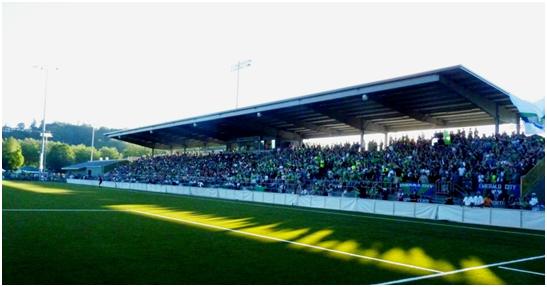
The match opened in frenetic fashion, with chances being created at both ends, and the Sounders have some sense of dominance, pinging the ball around within the area, but not managing to get past the defenders and put in a genuine shot. This helped the crowd to generate some noise and atmosphere and without the need for prompting from the announcer, in contrast to the baseball the previous night. At one end of the main stand, there is a group of supporters, styled as the Emerald City Supporters, who sang throughout the game, aided by a drummer and a German style leader with a megaphone. However this good start should have been nullified when Klein got free on the right in the 19th minute. Alan Gordon, a sub on Sunday managed to scoop his chance and it went over the bar. While Seattle had the most of the possession, it was again the Galaxy that came closest to scoring after 39 minutes. Again the move started with Klein on the right this time he put in Kirovski, who advanced to a tight angle, and then launched a shot which came off the near post. A typical home chance in the 42nd minute saw both Levesque and Jaqua trying to control a bouncing ball while the goalkeeper faced them but did not himself take the ball, the chance was eventually bundled away.
The second half started with Seattle again looking the better side but this time they managed to get from the ball bouncing in the area, to the ball bouncing into the goal. The ball was advanced, originally down the centre of the field, and then passed to the left from where Montana shot twice, the first effort being saved, the second coming off the bar. Much of the support were calling for a goal, but Jaqua was most alert and headed the bouncing ball into the net. The score was added to on 63 minutes. Again Montana was the man on the left, who delivered a perfect cross to Jaqua, who headed the ball in off the post. A chance for Jaqua to complete his hat trick, was blocked after Zack Scott crossed low from the left. LA Galaxy responded by making their 3 substitutions within a few minutes, while Levesque tried to place a shot past the goalkeeper and failed. A touch by Levesque in the 76th minute played Jaqua through in space, but the goalkeeper was quickly out and foiled another attempt to complete the hat-trick. This was his last chance, as he was taken off with seven to play.
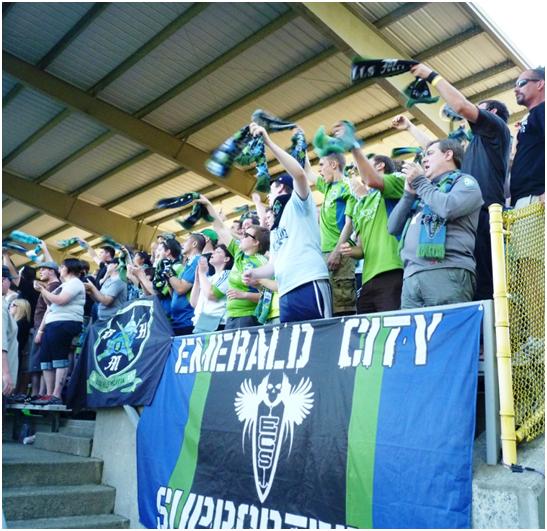
The ground is next to the railway line, and every few minutes we could see a train, trundling past one corner of the field. Most of these were freight, but it was noticeable that one passenger train had the word “Sounder” on its side. This was not a reference to the football club itself, but a reflection that both the football club, and the rail service take their names from the Puget Sound, a deep water channel that serves Seattle and gives it such a good position as a port. When one drives up and down the road between Portland, Seattle and Vancouver, you are treated with the greenery, mainly forested slopes coming away from the lowlands, and mountain peaks in the distance. Most of the mountains were green, but a small number stood up proudly above the others and had a white cap of snow on the peaks.
From here, my next port of call was Vancouver a return to Canada. Crossing the border, I was asked why I was going, I said to watch the Whitecaps the customs official then asked why? He let me through despite the fact I did not give an adequate answer. I went first to the centre of town, where I failed to get into the construction site where BC Place, the eventual home of the Whitecaps in the MLS next season. The construction of a new roof will not be done in time for the start of the new season, so they will start the season at the Empire Fields the stadium used when the Empire and Commonwealth games of 1954 were held in Vancouver. Good to see that neither the Empire Fields, or BC (for British Columbia) Place have yet taken to sponsor’s names. There are plans beyond this, that they may one day have a “soccer-specific” stadium in Vancouver, but the plans seem to be on hold at the moment, with 2013 being the earliest possible date for this venture.
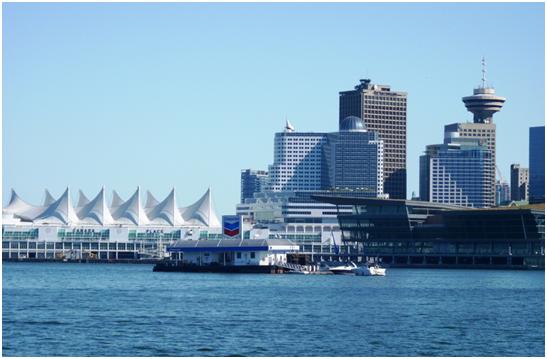
Apart from not accessing the stadium, the city is a good place to walk around, with a lively feel, and many pleasant vistas, especially when viewed from the waterfront. At one end of the city area is Stanley Park the name reminding me of the park between the stadiums in Liverpool I made my way over for a look. It was a recreational area with several features, including a grouping of totem poles.
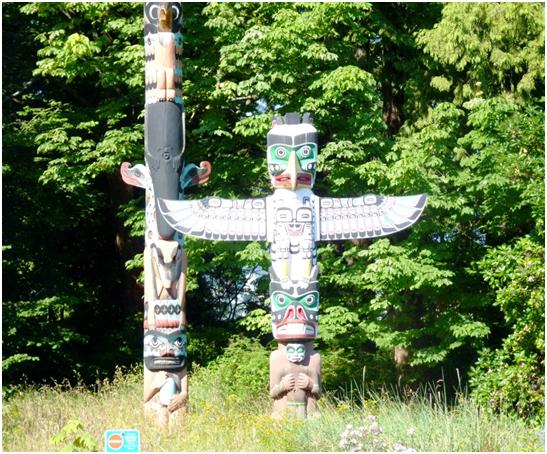
Stanley Park, Vancouver no football grounds, but several totem poles.
For the moment, they play at the Swangard Stadium, which is around a 30 minute drive from the centre of the city. As with most drives in America and Canada, once you are off the motorway networks, progress can be painfully slow, as you charge along for half a mile or so, and then stop at an interchange, where the lights hold you for three or four minutes. Roundabouts are a new fangled idea that have not caught on much in these parts, while busy intersections invariably include a phase for left turns when everything else cannot move, and the traffic turning left gets stopped if there are any pedestrians to cross the other road.
The Swangard Stadium is a simple affair, with a track around the playing surface. It has a covered stand on one side, and open seating opposite, while allowing some spectators onto the curve of grass behind both goals. At one end this is a VIP area, while the other is for the more vocal supporters. The stadium is named for Erwin Swangard, a journalist who raised around C$1 million for its construction. An unusual programme came in two parts, each a single piece of paper. One was a glossy sheet with some match details on it, which folded out to be slightly larger than 2 A4 sheets of paper, held longwise. With this, a simple slip of paper, unfortunately slightly larger than the main folded programme gave the two teams’ current rosters, Conference tables, and Vancouver stats.
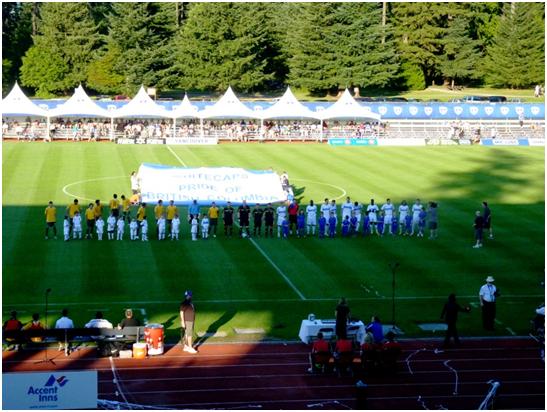
The visitors for the match were AC St Louis, AC standing for Athletic Club. St. Louis are new this season to professional football, although the city has a reputation as being a “Soccer City”, with a club in the old NASL until 1977. The filled their 5,700 capacity stadium for the opening match, but results have been disappointing and crowds have dropped since. With Whitecaps top of their Conference, and St. Louis bottom, (they are both in the NASL Conference), the game looked straight forward for Vancouver but this did not turn out to be the case. The club made a strange choice of coach at the start of the season, going with Claude Anelka whose only previous experience, (at Raith Rovers, where he got the job by promising £300,000 of investment), ended briefly with Anelka laughed out of town. Anelka did not last long in St Louis either meanwhile St. Louis have been criticised locally for putting all their investment into the new team, especially after their team in the Women’s Professional Soccer League folded.
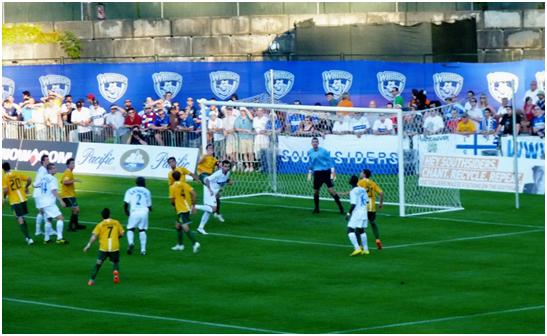
It was not for want of trying that the Whitecaps did not win the game they certainly held more of the possession, and were crossing the ball from both wings it is just that the crosses were uncontrolled and generally went over the penalty area. Particularly in the first half, St. Louis made little of the game typically of American teams, (especially struggling away from home), they played a five man midfield, with one player in a holding position between the standard ‘two banks of four’. This of course leaves the team with only one forward and in the case of St Louis, he got little support.
The second half followed a similar pattern with no score until only 18 minutes were left to play. A rare St. Louis chance fell to Jeff Cosgriff, and his shot was pushed away for a corner. When the corner came in from Luke Krealmalmeyer, Mark Bloom was left unmarked in the area, and took advantage of the lapse to put the visitors into the lead. The USSF ignores FIFA instructions on substitution rules, and allows up to five in this league. This gives a coach plenty of scope to change things, but results in a very disjointed game. Here there were seven changes in the last 30 minutes, five of them for Vancouver. St. Louis almost made sure of the game on 85 minutes when Gauchinho, their Brazilian import headed narrowly wide. It was a miss they regretted, as within a minute Whitecaps’ left back Blake Wagner hit a long ball over the visiting defence, into the path of one of the substitutes, Randy Edwini-Bonsu who calmly put the ball home.
A final score of 1-1, and I headed south straight away. With the reputation of the Canadian-USA borders to cause delays, especially for traffic heading into the states, I thought it better to cross late at night and stay in a motel not far south of the border. My policy worked in so far as I did not have to queue, and while at the Detroit border, they had still held me up by almost an hour asking questions and getting me to fill in forms, (which were promptly thrown away), all this border inspector asked was where I had been. I answered “day trip to Vancouver” and did not even mention the football and with that, he allowed my passage!
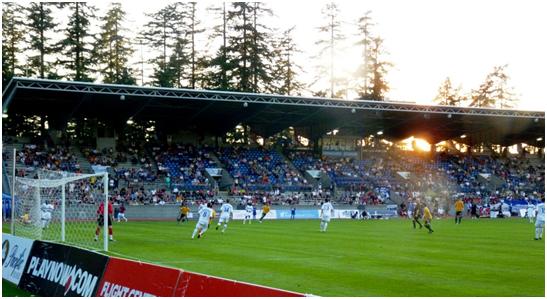
To most people, the name Tacoma either means nothing, or reminds them of the Tacoma Narrows Bridge, which collapse spectacularly in 1940, and more importantly, was filmed as it collapsed. I paid a visit to the site, where two new bridges carry the freeway over a channel of the Puget Sound,. Not only is there no obvious commemoration of the original bridge, but I could not even buy a postcard (showing either). So instead I drove down the coastline for a mile or so, and cut inland to an area known as University Place. I then found the Curtis High School, home of Tacoma Tide, a PDL level club. The high school grounds has a large stadium with artificial surface. Confusingly, all the markings for American Football, Soccer and at least one other sport are marked out, albeit in different colours. The stadium also has a running track. On the side you enter, there is a large seated stand, covering the whole length of the field, while opposite there are a few rows of metal bench seats on scaffolding. Most of the crowd, estimated at 65 were in the main stand, but a small number including one couple displaying a Canadian flag sat opposite. I thought to enquire as to whether this couple were supporters of the visiting Vancouver Whitecaps, but they said they were just tourists travelling around. I struggle to believe Canadians could turn up here by chance, any more than I did. Now you have noticed that I visited the Whitecaps 24 hours earlier. This time it was their PDL team, under the title Vancouver Whitecaps residency. The exact status of the PDL is difficult to define, teams are only allowed to have 8 players over the age of 23 in a squad of up to 26 players, but nothing stops them playing all 8 throughout the games 90 minutes. Still with a team allowed to name seven substitutes for a match, and then to play six, (subs cannot return after coming off), it is unlikely this would ever happen. In fact few of the teams have more than a couple older players, and Vancouver Whitecaps Residency does not have a player older than 20. Their oldest player was none other than Randy Edwini-Bonsu, who had played 23 minutes and scored the equaliser on the previous evening. As well as Edwini-Bonsu who had started when I saw Vancouver win in Montreal; the PDL team also featured Doudou Toure who was a non-playing substitute on both occasions I had seen them play. Of course, in the USA, the main place for youth football is the college system, and many PDL players also turn out for college sides.
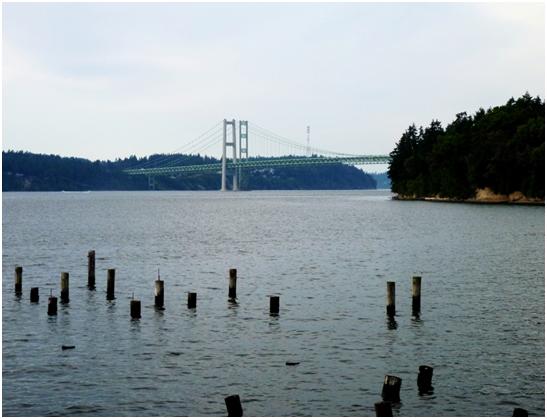
The new
Tacoma Narrows Bridges.
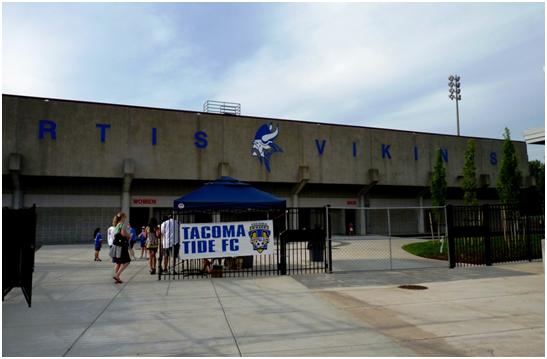
The full name of the High School Team, as shown on the stand is Curtis Vikings
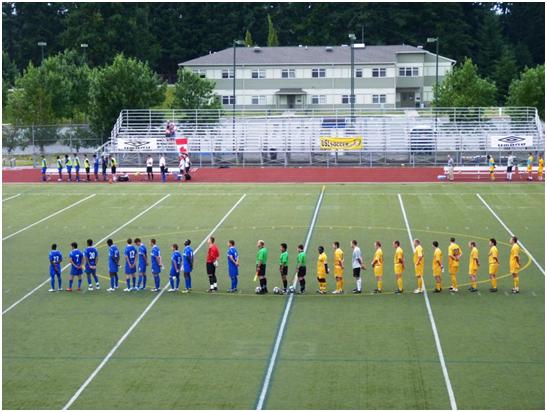
Confused markings, for soccer, they use the yellow circle, but also the white centre line. Note the Canadians on the left of the seats.
Tacoma Tide, which also runs a basketball club under the same name is just off the running for a place in the play-offs, (they need to finish second behind Portland Timbers U-23 team). There coach is Gerry Gray, born in Scotland, but naturalised as a Canadian having moved at the age of 12. He is a former Whitecaps player (and a dozen other clubs in USA and Canada) as well as having 34 caps for the Canadian team. Tide have three players over the age of 23 in the squad all started, but two were substituted before the end.
I feel the correct two Whitecaps players were in the first team squad, as the pair appeared to be the best the team had on offer. Whitecaps lined up in a 4-2-3-1 formation, while Tide played in 4-1-4-1. With only one forward each, neither side showed much adventure up front. Apart from the confusing markings, this appeared to be a harder surface than other artificial pitches I had seen, creating a difficult bounce. Still, there were a few chances at each end, and Whitecaps should have taken the lead just before the break. Toure was brought down while trying to break through the defence and took the penalty himself. It was not a badly taken penalty, low and to the keeper’s right, but he got down well to save it. Tacoma made the most of this, when six minutes into the second half, Rory Agu (without a doubt, their best player, and one I imagine might be moving to a neighbouring professional side) broke through the defence to score the only goal. As the game went on, Tacoma appeared to have the better of the later stages, which is not what I might have expected, as the visitors assumedly train as a full time team, but there was no other goal to celebrate. Only one substitute more than the normal number in this game the visitors making four changes in the first 22 minutes of the second period, including taking off both Toure and Edwini-Bonsu.
Despite the low turnout, there were three Tacoma fans who put up banners, waved flags and tried to sing through the game. The players appeared to appreciate the support. They held season tickets and went to most home games, but did not travel away. The PDL has a 16 game season if they do not make the play-offs, with the Tacoma schedule for home games consisting of two matches in May (in one weekend), three in June and 3 in July (including two on successive days). It was US$10 to enter, with a season ticket costing US$70. The match programme, which is free, is a single sheet of A4 with one team’s roster on each side, interspersed with a little publicity for sponsors, the Conference table, but no notes. The trio of regular fans said they had season tickets but were uncertain whether they could see the Saturday game, as it was to be played in the state capital, Olympia, about 20 miles away. Away from home, the team has one double header weekend when they visit two of the division’s Canadian teams, Vancouver and Victoria Highlanders five of the division’s teams are in Washington state, with Portland being the only one in Origen.
In order to lessen the travelling burden, double header weekends are not unusual in the PDL, and Tacoma were due to play another Canadian team, Abbotsford Mariners the following day. Abbotsford were playing Portland Timbers U-23 on the Friday while Vancouver were to go to Portland on the Sunday. As it happened all four games were wins for US teams, over their Canadian opponents
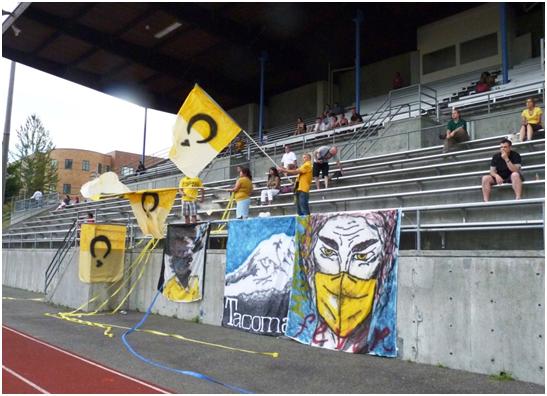
The Tide Fan Club the flags show the moon, because as they told me, the moon controls the tide. Meanwhile the poster on the right wears a mask because he is suffering from “Yellow Fever” the club plays in yellow.
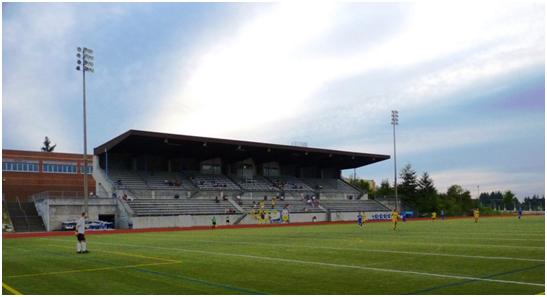
Main Stand at Tacoma.

Paying the Penalty. Doudou Toure’s penalty is saved by Tide goalkeeper Scott Barnum. Randy Edwini-Bonsu, who had scored for the first team on the previous night, is the player infringing on the right.
Driving through Washington state means taking a motorway that is somewhere between the mountains and the ocean. The massive inlet of the Puget Sound is the backdrop one side of Seattle and Tacoma and runs down as far as Olympia. Although neither Vancouver, nor Portland are in this state, they are close to the borders, so most of my time on this leg of the trip was in Washington. To the East, one sees a range of quite high green hills, with a small number of snow covered peaks standing majestically on their own. This is volcano country, and I think it is the volcanic activity that allows some of the peaks to grow aloof from the surrounding hills. I have some time on my way to Portland, so I head inland, and end up by side of Mineral Lake, a setting where the active American can park his RV, do some swimming or fishing, and still get satellite TV. Mount Rainier hides just behind the first line of hills.
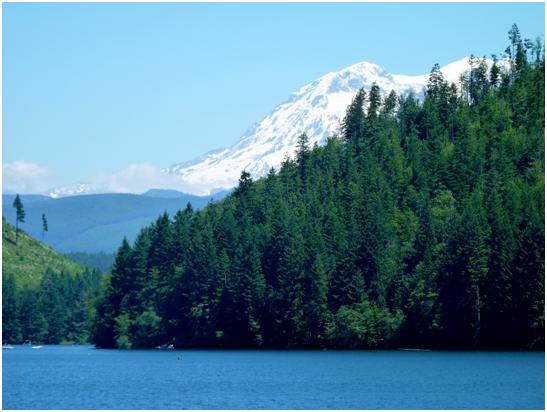
Twenty minutes later, I get a better view from the roadside.
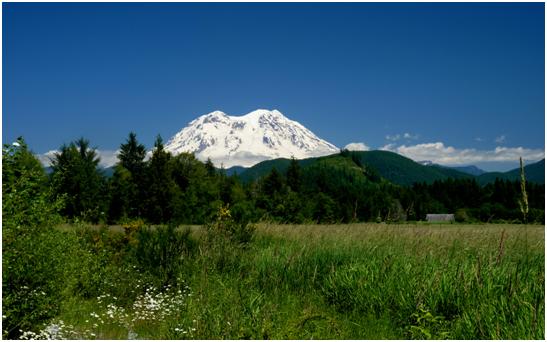
Portland itself is another bustling city, but I have no difficulty parking immediately outside the ground (several hours before kick off). A tram saves me the walk down town, although the distances are short enough (about 20 minutes) that I end up walking back. It has the standard mixtures of new and old (as in 90 or 100 years) buildings, with the older ones always being the more attractive, and a spoilt riverside that is underutilised, and anyway gives you views of the giant motorways that soar way above your head. Another mountain, in this case Mount Hood, occasional shows its peaks in the distance. From the central shopping area, I walked to the riverside, then through a market area and back past some theatres to the centre.
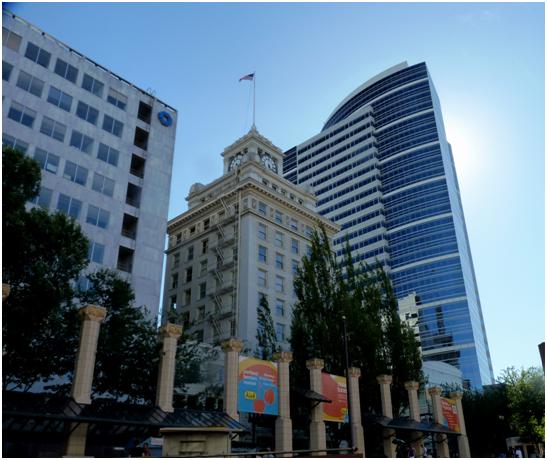
Different styles in Portland and no the buildings are not an angle, it’s just the effect of a wide angle lens.
Portland did boast what I considered to be the euphemism of the month. In one area, where the four lanes of traffic were quite quiet, there was a notice up to say that as an “anti-congestion” measure, to drive a car down this road more than twice in a short period of time, between the hours of 10 P.M and 6 A.M (they don’t like the 24 hour clock) would be committing an offence. Had my schedule allowed me to stay as late as ten, I would have driven down the road, (not more than twice), just to see the traffic jams. As it was, I had a flight at 10.20, and the match was not scheduled to finish until close to 9 so I certainly needed to avoid any congestion.
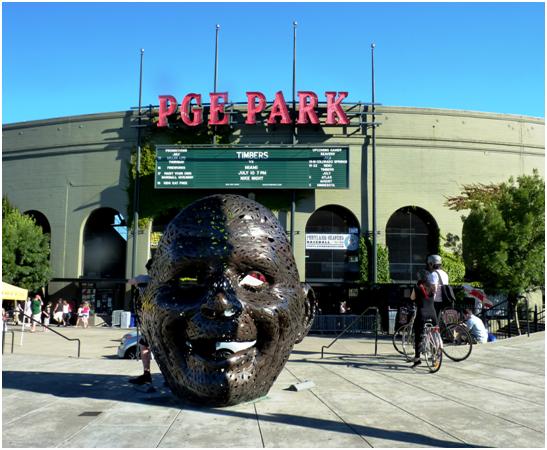
PGE Park in Portland is uneasily shared between Soccer and Baseball (it has had other names in the past, including the bland Civic Stadium when no sponsor has been available. PGE = Portland General Electric). One can see different colours and patches where the artificial turf is replaces after a baseball game, and near one corner, the batter’s plate is still plain earth. There are plenty of seats, but only two sides are properly utilised, the stand behind to goal is a curve, while the main side is parallel to the pitch but quite a long way back. At pitch level, and for half the length of the pitch, there are tables being used as an open air restaurant with a buffet service. On the opposite side, there is a single row of seats high above the pitch, with a tented area in one corner, assumedly providing some type of food and drink service. Being a baseball ground, there is a concourse behind the seats at the top of the lower tier, selling all sorts of food, beverages and souvenirs. The oddest feature is a small section jutting out from the side of what appears to be an adjacent building. This provides about five rows of seats behind the goal, and suspended about 20 feet above ground level . This building also has a flat terrace at a slightly lower level, from where a few people were watching. Some of these, curiously was watching the game while furiously peddling away on an exercise cycle. For next season, a new stand will be added on the East side of the ground, and a low row of seats behind the south goal, putting fans on all four sides. The ground will no longer be shared with baseball, allowing it to become a more closed in soccer venue, and while the pitch will still be artificial, it will be a fresh pitch with no joins where the bases once were.
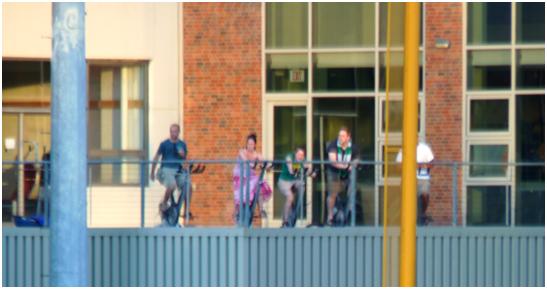
The fitness fanatic way to watch football and yes, the one on the right, while pedalling a gym bike with the temperature well into the 80s, is wearing a green football scarf.
Timbers did not capitalise on an early chance, when DeMartin blasted the ball over. On 15 minutes, Pore beat a defender and ran down the left channel before delivering a pass to the head of Bright Dike, who unfortunately directed the ball straight to Caleb Patterson-Sewell in the Miami goal. While Portland were playing a straight forward 4-4-2, the Miami formation was more complex. Listed as 4-3-3, but the right full back had a tendancy to push forward, while he left sided counterpart did not. All of the midfielders were either centre or left, with the right side being dealt with either by Euzebio Neto, the full back moving forward, or Edward Santeliz, a forward dropping back. This was not a technique that was really affective, and most of Portland’s chances in the first half came from this channel. Pore came close to scoring again on 28 minutes, shooting across the goal to the far post. Miami wasted a rare attack when Paulo Araujo shot wide from at least 35 yards with other, better options available. The left side continued to be the place where Portland piled on the pressure.
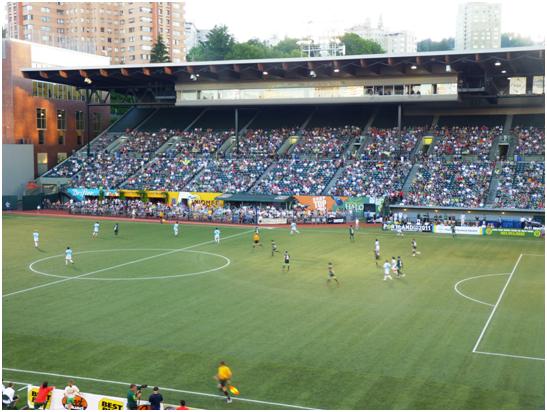
Portland finally took the lead in the 48th minute, when a free kick from the right appeared to hit Ross Smith, who still needed to goes to get the ball across the line. Surprisingly, the home team did not push on from this position, and instead it was Miami who now came to the fore, with Christian Gomez finding space on the right on several occasions, but always failing to deliver the ball accurately. It seems a common failing in this league that players need to take too much time on the ball before passing or shooting, and this was certainly Miami’s problem. Still they certainly should have levelled the scores in the 79th minute. Three times, Miami players had shots blocked or saved in a single move before the ball was bundled away for a corner, which was over hit and ran to safety.
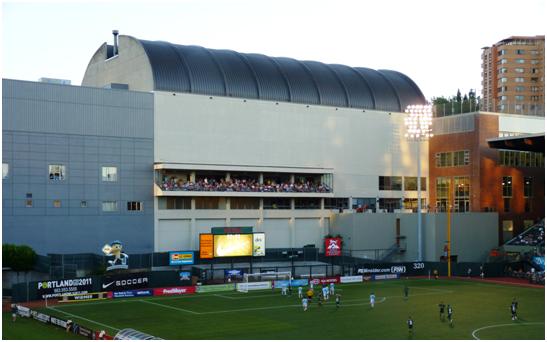
Behind the goal, with the small stand. Another few rows of seats will be added close to ground level next season. The fitness cyclists are on the right, between the floodlight pylon, and the yellow pole (which marks the foul line when baseball is on the stadium).
Mandjou Keita missed a golden chance to make the game safe in the 88th minute, somehow managing to pull the ball past two defenders, but then hitting a shot wide. This left Ryan Pore with the job of showing how it should be done picking up the ball in midfield, he accelerated past two defenders, and then calmly slotted the ball past the advancing goalkeeper, much to the satisfaction of the Timbers’ very noisy home fans, who had kept up a good series of chants throughout the game.
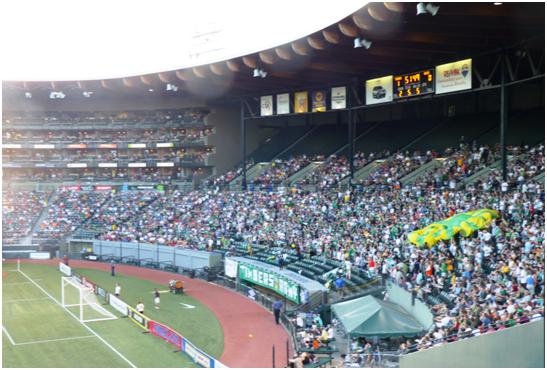
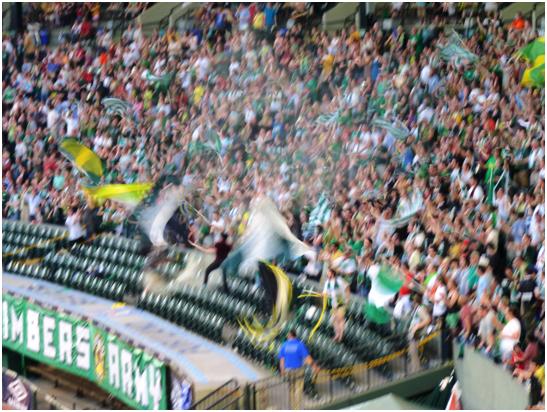
More than any other group of fans I had encountered, those behind the goal at Portland were mimicking the best habits of the English, waving flags and scarves, and singing some of the same songs.